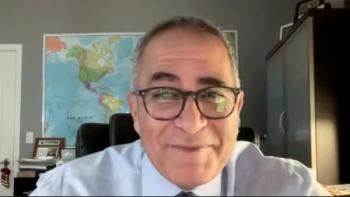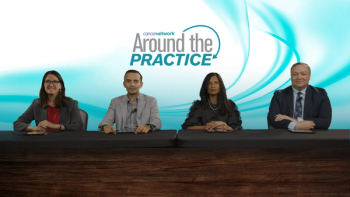
Patient Case 3: Development of CRS on a Non-BCMA Targeted Bispecific Antibody
Centering discussion on the third patient case of multiple myeloma, key opinion leaders consider the development of CRS on non-BCMA targeted bispecific antibody therapy.
Episodes in this series

Transcript:
Ajai Chari, MD: Let’s move to our third and final case. Annel, back to you. Walk us through this case.
Annel Urena, RN: Patient case No. 3. This is a 62-year-old man with IgA lambda multiple myeloma. He was diagnosed in 2017, and he has had 10 lines of therapy previously. DS [Durie-Salmon] stage is IIIB, and ISS [International Staging System] stage is unknown. His past medical history involves hypertension, GERD [gastroesophageal reflux disease], CKD [chronic kidney disease], prolonged QTc, and steroid-induced diabetes. When he started, M-spike [monoclonal protein] was 0.68 g/dL, IgA was 554 mg/dL, and lambda was … mg/L. He had 30% of plasma cells, plasma cells involving 30% of the cells. Lambda was restricted to 31% on the smear.
He was enrolled on clinical trial with cevostamab at a 160 mg dose. He received priming doses, and on the following day, he developed CRS [cytokine release syndrome]. During admission on cycle 1, day 2, he developed grade 2 CRS after receiving 2 priming doses of cevostamab. The patient developed fevers of 103.5 °F, chills, tachycardia, and hypoxia. He had [an oxygen saturation] in the low 90% range. He denied shortness of breath, headache, visual changes, dizziness, or myalgias. He had a nonproductive cough present before screening due to [human] metapneumovirus. But he denied any sneezing, runny nose, sore throat. Vitals at the time were 103.5 °F. His heart rate was 115 beats per minute, blood pressure was 100/60 mmHg, and he had [an oxygen saturation of] 90% on room air. His ICE [immune effector cell-associated encephalopathy] score was 10 of 10. We did a chest x-ray, which was normal. We sent an infectious work-up, including swabs that were negative. CRS and infection work-up was completed. We gave a dose of Tylenol as needed for fevers and 1 dose of tocilizumab. We gave some hydration. We also gave 2 L of oxygen because he was de-saturating. Dexamethasone 10 mg IV [intravenous] every 6 hours was given for 24 hours only. Once we got this CRS work-up, the lab showed that the interleukin-6 was elevated at 142.3. IL-1 was elevated, at 20.7 pg/mL. IL-8 was elevated, at 3307 pg/mL. The tumor necrosis factor was elevated at 224 pg/mL. Also, CRP [C-reactive protein] was 7.4. The infectious work-up was negative. After all interventions were completed, he had improvement of his vitals.
Ajai Chari, MD: Robert, this case is a non-BCMA bispecific, which by definition means it’s not clinically available commercially. This is a study patient. I call it T-cell discrimination because tocilizumab isn’t on label for bispecific. What are your thoughts? In clinical trial experience, tocilizumab is provided by the study. But then we go into the real world, and there’s a big gap of what to use and who’s paying for it. Any thoughts on real-world bispecifics?
Robert Mancini, PharmD, BCOP: You bring up being able to have tocilizumab provided by the study. We have 1 bispecific study in progress that we’re trying to bring, and they provide that. Trying to coordinate between commercial vs study drug can be very difficult. But if we’re bringing a new drug to market, we look at something like tocilizumab, which isn’t mentioned anywhere in the PI [prescribing information] because it’s not FDA approved for that indication. When we’re authorizing this drug, we also have to get a separate authorization for the tocilizumab in preparation for the possibility that we may need to use it.
In a cancer treatment center, if you don’t have CAR [chimeric antigen receptor] T-cell products or other bispecifics, you may not routinely keep tocilizumab on the shelf. That might need to be a change that you implement, with at least 1 or 2 doses always available in that outpatient infusion center and hospital for these situations. But the biggest concern we have is that sometimes, because they don’t have this specific indication, you may have to say, “These are our guidelines.” If we have a bispecific with CRS or ICANS [immune effector cell-associated neurotoxicity syndrome], this is how we’re going to manage the CRS or ICANS regardless of what that bispecific therapy is. Even we face this issue with CAR T products, where the guidelines recommended are slightly different between each product. When we deal with that, it’s very complicated, especially if you have individuals coming in who aren’t always familiar with every specific product and difference. In the practice setting, dealing with commercial products that cause CRS or ICANS, my recommendation is to create a standardized guideline on how you’re going to manage these regardless of the product.
Ajai Chari, MD: During the pandemic peak in 2020, we were in New York City, in the epicenter. But we were giving T-cell direction therapies. As part of our weekly meetings pharmacy was saying, “Do we have enough tocilizumab for the CAR Ts and bispecifics this week?” It’s an iterative process that will potentially change in the future, depending on what happens with COVID-19. The other pearl on this case, is that this patient got Tylenol and tocilizumab but still needed more attention. Kiah, any thoughts on how quickly you expect improvement? What should the index be to add additional and interventions in this case if you’ve already given Tylenol and tocilizumab?
Kiah Purcell, NP: Usually, we see an improvement with tocilizumab within a couple of hours. With this case, I’m unsure if the dexamethasone was started without improvement. But if the patient isn’t clinically improving within a couple of hours—in this case, this patient had low oxygen levels—we’d consider different management for sure.
Ajai Chari, MD: That’s the key. When the patient isn’t improving with tocilizumab, they have a very low threshold for expanding treatment of infections as well as CRS and ICANS, doing parallel processes so you’re covering all your bases. Let’s face it: dexamethasone is the patient’s least favorite drug. These are intended to be steroid-sparing regimens. However, this initial priming period isn’t the time to be sparing with dexamethasone because of the importance of blood-brain barrier penetration if the patient isn’t responding to conventional therapies.
Transcript edited for clarity.
Newsletter
Stay up to date on recent advances in the multidisciplinary approach to cancer.




![“[This approval] will be a quite dramatic change in our philosophy and practice in multiple myeloma," according to Joseph Mikhael, MD, MEd, FRCPC, FACP, FASCO.](https://cdn.sanity.io/images/0vv8moc6/cancernetwork/3cab3ada4c023b68c118240a512e31d72a7f931b-1200x628.png?w=350&fit=crop&auto=format)

















































































